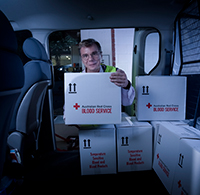The Blood Service is reviewing the different ways we pack our shipper boxes to help ensure blood products maintain the correct temperatures during their trips to customers.
The Blood Service uses several different methods of packing products for delivery to customers. This is because of the different transport conditions needed for the three lines of fresh blood products (red cells, platelets and plasma), the diverse routes we transport across and how we have previously qualified our transport processes. ‘Qualifying’ a transport process means verifying it can keep products within the correct temperature ranges for a specific period of time based on a standard ambient (outside) temperature.
However, this qualified transport time actually only covers a small percentage of the many routes we use to transport our products. Also, having multiple packing systems increases packing time and errors, requires the expensive and time-consuming use of data loggers (which accompany blood shippers to ensure components have been transported within acceptable temperature limits), and results in additional handling for customers receiving the products.
That’s why Graham Shepherd, Project Manager, and the Blood Service Manufacturing Project Team are investigating options to improve the transport of fresh blood components from the Blood Service to customers.
One aspect we’re focusing on is increasing the qualified transport time of a given packing configuration by using a dynamic ambient temperature profile (which mimics the temperatures and durations a shipper is likely to be exposed to en-route to its destination) in the qualification process. Using previous work performed by SA Health and results from our data loggers we’re confident we can achieve improvements.
Also, from June this year we’re doing a year-long study gathering data on the ambient temperatures consignments are exposed to during their travels, which should also help us determine the best way to transport them long term. For this study we’ll be asking for assistance from a number of our customers, particularly in regional areas — you may hear more about this from us soon.
Finally, we’ll be evaluating whether using a more advanced, phase-changing coolant material — which is more specific to the temperature range than our current ballasts — will reduce platelet temperature excursions during transport.
Graham says of the two-part project, “Our goal is to ultimately have fewer packing configurations for each component, longer validated transport times and more robust configurations available for transporting platelets. Further, we will be in a better position to assess the capability of our current blood transport shippers and the requirement to assess new shipper options.
“All of which should reduce errors and out-of-temperature consignments and make life easier for our customers.”

